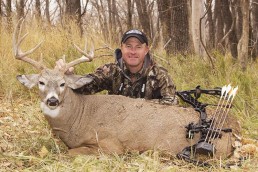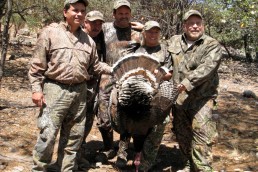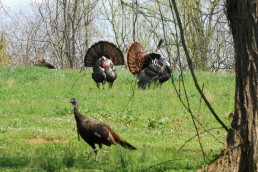In His Own Words…Mark Kayser: Rare Bird Chasing Antlers and Fur
SHARE THIS POST
We live in the Midwest, and, chances are, so do you. A lot of people, in this day and age, live close to a lot of other people in places that are more roads and buildings than anything approximating wilderness, and there is a lot of talk about how we would all benefit from spending more time outdoors. On this modern landscape, a few people purposefully make their way to where there are far more fenceposts than street lights, and some of the posts have old upside-down cowboy boots on them and Mark Kayser is one.
One of those guys who will always look a lot younger than he is, blessed with roughly equal parts physical and mental strength, Kayser grew up on the western edge of MidWest Outdoors territory, out in South Dakota, before moving to the mountains of Wyoming a few years back. One of the finest outdoor still photographers of his generation, yet good enough as a writer that his words can carry their own water. He has also learned to be a video producer, hosts television segments, and in tide with the times, contributes to a number of blogs.
He reminds us of the best of John Grady Cole, principal character in Cormac McCarthy’s novels, like All the Pretty Horses and Cities of the Plain. Mark Kayser kept going until he ran out of traffic and fences and settled where he could live as a hunter, photographer, writer, one of the few remaining fulltime freelancers.
The portentous reality of being a rare and dying breed is not lost on him. Who knows what the digital revolution will continue to do to the profession of the outdoor “writer,” but for now, Kayser is living the dream like few others are.
During peak of fall, when so many of you travel west to experience a week of mountain life, to chase mule deer and elk with bow or gun, to glass endless expanses looking for a pronghorn to stalk, we present the story of a man who went out there with the intention of finding a life that suited him like it has generations of cowboys and ranchers and artists and the sun rises and sets against a magnificent background most days of his life now and he reports what happens out there so we can be better hunters, and here he is, Mark Kayser… in his own words.
MidWest Outdoors: Being a fulltime freelance outdoor communicator makes you a rare bird these days. But living in the Wyoming mountains while you do it makes you pretty much a relic of days gone by. Give us an overall idea of what you do for a living.
Mark Kayser: I’m an independent freelance contractor. I love hunting; it’s my biggest passion, and I convey that through photography, writing, blogs, video blogs, and network TV. I like supplying content, good hunting information, and entertaining at the same time.
Everything I do is a hundred percent pure hunting. I do do-it-yourself stuff, and I hook up with outfitters, but it’s not manufactured. Some of these hunts on TV, they’re just too set up, and a lot of the stuff you see on TV, and even in articles, you don’t learn from it. When I see something on TV, I want to be entertained, but I want to learn something as well.
When I do a television show, or a video blog, or write something, I try to make sure people leave with a new strategy, a new tip, a new tactic, some new gear that they might want to try, that I’ve used in the field.
MWO: Where is your video blog?
Kayser: You can go right to my website, markkayser.com and one of the easiest ways to find out what’s going on day to day is click on the links to my Facebook page and Twitter account. And there are links to the blogs I write for, and videos I post online.
MWO: You like to hunt big game animals, especially deer, but you chase pretty much any animal, right?
Kayser: Right. Most of my stuff is antlered, or furred, hunting. I love turkey hunting, and I used to be a pheasant hunting nut, but after moving to Wyoming, we chase a lot of big, big critters these days. And I just love antlers. But when I’m not chasing antlers, I like to go out and call coyotes in. That’s my other big passion.
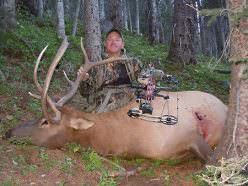
Comfortable pursuing big animals with antlers with a bow or gun, Kayser poses with the public-land bull elk he describes below, and an ultra-wide-racked deer taken with a rifle on the snowy plains.
MWO: A lot of people who are avid hunters would love to trade places with you. But this is a difficult time for independent media producers. What does it take to succeed?
Kayser: It’s very challenging. I get this a lot: people say, “I’d love to do what you do.” I always think, “maybe you would, in your mind,” but the reality is you have to be very driven, very organized, and you have to know how to make a dollar from nothing, basically.
You have to be able to write well. If you’re going to school and not taking English classes, you can’t do what I do. You should take speaking classes, too; if you’re not in debate, in both high school and college, you would have a harder time doing what I do. Some people have the gift of gab, can maybe sell used cars, but there’s a bigger leap to be made in order to be able to participate in round tables on camera, things like that.
Plus, you have to have a passion for the outdoors, and be out doing it, because until you do it, live it, learn it yourself, and learn through a lot of mistakes, it’s hard to do what I do. I don’t get a big buck every year, or a big bull elk every year, but I learn something every year. Then I share that with people. “Hey, this is how I screwed up, and the way I found success.”
MWO: You are definitely honest about what happens to you out in the field. It seems that readers, viewers, listeners, get more out of it when they can relate to someone who admits they don’t get huge fish and enormous animals every time they go out there. That you, like everybody else, have bad luck, make mistakes, and work your way to success.
Kayser: Exactly, and here’s a story that will drive that home. Two of my favorite elk hunts were this past fall. First, my son, Cole, shot a very nice 6×6 bull––early in the season, in one of Wyoming’s historically lowest archery success units. We were doing do-it-yourself, public land hunting, like anybody can. And then I went back on my own, to try to fill my tag.
The elk were doing a whole different thing when I went back up into the mountains, and I shot a 5×5 bull, what people call a Raghorn. It was one of the toughest hunts I’ve been on, but it was one of the most rewarding, because I found the elk, set up the strategy I wanted to use, and it worked.
It was kind of an unusual strategy; I didn’t even call. I patterned him, just like whitetails. Shot him in a pattern situation, then packed that bull out by myself, on my back. It’s not a giant bull, but it’s one I respect because I hunted him all by myself, right in a spot where you or anybody else could go and hunt, on public land.
Because I try to make my living communicating about the outdoors, I have to be out there a lot, and I hunt private land, too, and I hook up with outfitters. So I get a taste of every type of hunting. And no matter what I learn, I want to make sure I can share it with my audience. “This is how we tried to call coyotes on public land and got beat up.” “Here’s how we did it a different time and had success.” I’m out there, lots of times, right with the regular crowd, punching away on the public land, and I love it.
MWO: You have great writing skills, and have developed your filmmaking skills, but you started out your career as primarily a still photographer, right?
Kayser: Exactly. I had this intention of being the next Leonard Lee Rue III. And I have done, and still do, a lot of photography, but these days it’s more about hunting images, photos that show tactics, photos that show areas where we were hunting. To this day, I still love just picking up a camera. This year, I spent three days just photographing elk, just sleeping in my truck like I did in the old days. Those are images I can use in my work, images of elk that I can supply with articles that I write later.
MWO: There is a lot of interest in shooting better photographs of wild animals in their natural habitat. Do you have a couple tips on how we can take better wildlife shots?
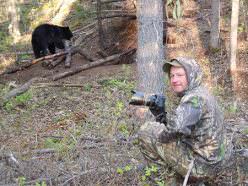
Don’t try this at home; Kayser is a veteran wildlife photographer who spends many days in the field shooting images to illustrate his writing.
Kayser: I think what you need to do is kind of ignore where you hunt, because those animals are hunted, and they’re not going to just stand around. Especially in today’s world, urban settings have a lot of urban wildlife, and those animals are accustomed to people. Say you’re living in Minneapolis, or the Chicago suburbs, there are a lot of whitetail deer living in people’s backyards.
Just do a little driving in the afternoons and try to find those spots, where there’s a nature area, or a park setting. Those deer see people every day, so they’re a little easier to get close to. So if you want to get some great images without having to wait out long days in a blind, think of these urban settings.
If you want the image to show the animal, but not standing in front of a Walmart store, set up so you have kind of a wild-looking background behind the animals. Move around until you can see natural things in the background. You can get lots of great pictures in places like that, without having to spend days in the backcountry.
MWO: How about equipment: can you give us an idea of what you think of as a good starter kit? Say, one or two “affordable” lenses that might make a big difference?
Kayser: I think you should look at a zoom lens that has a variable aperture. You can find some good lenses that start out at maybe 35mm and go up to 300mm. In today’s market, there are some very sharp lenses that don’t cost a fortune, that hold sharpness throughout the whole zoom range. If you’re looking to get into mainly wildlife photography, I would look for maybe an 80-300mm zoom. Then invest in a good quality 1.4x tele extender. The extends increases the focal length of the lens 1.4 times, so you end up with a 112-420 millimeter lens.
Compare that to buying a high-end lens with the ability to open up to an f2.8 f-stop. That low-light performance is what really drives the cost of a lens up. So if you shop for a lens with maybe a maximum aperture of f4.5, then it will be much less expensive.
MWO: So you’re saying that affordable lens, with a 1.4x tele extender, will help us take good wildlife photos in most situations?
Are you enjoying this post?
You can be among the first to get the latest info on where to go, what to use and how to use it!
Kayser: Especially when you’re dealing with animals that are accustomed to people. If you’re trying to shoot bighorn sheep in the wilds, up in the mountains, then you’re probably going to need a 500mm or 600mm lens, with an f2.8.
MWO: But then you have to get your wallet out, right?
Kayser: You have to mortgage the house [laughs].
MWO: How critical is it to shop for a quality tele extender, and about how much should we expect to pay for one that’s acceptable quality?
Kayser: Probably a couple hundred dollars.
MWO: How much should we expect to pay for the lens?
Kayser: You definitely want to spend as much as you can afford. It’s just like with binoculars, you are buying good glass when you buy a quality lens. But there are a lot of affordable lenses out there that will provide great images, stuff that you can frame and put up on the wall.
MWO: Let’s get into some hunting information now. For somebody just getting started in hunting, lay out the essential foundation of what they would need to know and do, in order to begin to learn the art of hunting. Broken down to simple steps, what are the secrets to becoming a good hunter?
Kayser: There are two things you need to know. Number one, you need to know your quarry, the animal you’re after. Study all their characteristics, their behavior, their likes, their dislikes.
MWO: And there are more ways to do that now than ever.
Kayser: It’s unlimited, on websites, on your smartphone using apps, you can watch videos on how whitetail deer do their breeding, like scraping and rubbing their antlers, and running scrape lines. All these things are easy to find.
Back when I was learning to hunt, I did it by the seat of my pants, learning it all out there. And no matter where you get your information, at some point you have to get out there and experience things, so you really learn them. If you know a lot about the animal you’re after, you will know when you need to be out in the field, where you need to set up, when you don’t need to be out there hunting, and how to take the animal.
And number two, you need to know what other hunters are doing. You need to know where they are and how they’re hunting, where they’re accessing the land from, and whether they might impact your hunt.
Take weekends, for example. Everybody has that time off, so there are a lot of people out in the field. But say you have a job where Wednesday is your day off. That should be your key day to be out hunting. The animals know it, because they know pressure. They sense when there’s more people around them, and they act differently.
On those days when there aren’t as many people in the field, they act more relaxed, moving about more. So, learn your prey and study hunting patterns so you can do the opposite of what other hunters are doing.
MWO: So you believe strongly in approaching hunting areas from a different direction than where most hunters come from. But there’s more to your strategy, right?
Kayser: If I don’t have to park in a designated parking area, I don’t. I always look for a back door, or a side doorway into an area. Because the animals know exactly where the main pressure comes from. They can feel it when that parking lot fills up, so instead of being near the parking lot, those animals are already moving to the far end of that 2,000-acre wildlife management area. They’re maybe even crossing the fence, onto private land.
If you know that, you can be back there at sunrise and cut those animals off as the main parking lot crowd pushes forward. It’s like they’re doing a big deer drive right to you. Or, you’re set up back there because the turkeys can feel the pressure near the parking lot, so they’re roosting a mile away from there now. They’ve had enough of being bothered. They move their roost site, and you’re back there with them, in the farthest, roughest corner, and you had to wear waders to get across a creek, and now you’re all by yourself, with the turkeys, because other hunters don’t go to the trouble to get all the way back in there, especially before it gets light in the morning.
Kayser through the years
March 5, 1966: Born, in Dell Rapids, South Dakota.
1982: As a high school sophomore, got serious about outdoor photography. Within two years, Kayser’s photos were published in the South Dakota Conservation Digest, and soon after that, sold his first magazine article, to Great Plains Game & Fish.
1988: Graduated from South Dakota State University with a degree in News Editorial Journalism, minor in history, and an emphasis in Fisheries & Wildlife science.
1988: Married to wife Sharon, in Dell Rapids, South Dakota.

Spring turkey hunting is a tradition in the Kayser family. Daughter Katelyn was on the gun for this river-bottom gobbler. Mark’s wife Sharon and son Cole were also along on the hunt.
1988: Fresh out of college, started working for State of South Dakota, helping promote the state’s outdoor opportunities. As a writer, photographer, and media relations specialist, Kayser spent 14 years in various positions.
1997: Son, Cole, is born.
1999: Daughter, Katelyn, is born.
2002: Took the plunge and went fulltime as a freelance photographer and writer, selling articles and photos to outdoor publications. Eventually widened his craft to video and television production.
2007: Moved to Sheridan, Wyoming, to a spread on the edge of the foothills, where the family lives with a couple saddle horses, a mule, and a Border Collie named Sage.
2008: Killed his largest whitetail deer, in central South Dakota, that scored 207 inches, on a do-it-yourself hunt.
2010: Received A.H. Pankow Award from State of South Dakota, in recognition of “contributions made to print and broadcast media, showing love and respect for the outdoors, and a legacy of sharing hunting skills.”
Hear the rest of the interview…
There’s much more to our conversation with hunting legend Mark Kayser, and you’ll find it in the Podcast section of MidWestOutdoors.com. On the home page, look for the button that says Podcast, click on it, and you’ll find the Kayser interview.
And we hope you have time to listen to some of our other feature interviews as well. We’ll see you there… it’s time well spent.
MWO
SHARE THIS POST
Did you enjoy this post?
You can be among the first to get the latest info on where to go, what to use and how to use it!
Mark Strand
MidWest Outdoors editorial director Mark Strand is a graduate of University of Minnesota School of Journalism with a minor in Fisheries & Wildlife Science. He has written for nearly every outdoor magazine over the past 41 years, and has written or co-written 14 books. In addition to writing and photography, Strand produces the MidWest Outdoors Podcast, and contributes to MWO digital properties. He is an outdoor generalist who loves hunting and fishing of all types. In 2018 Strand was elected to the Minnesota Fishing Hall of Fame.
